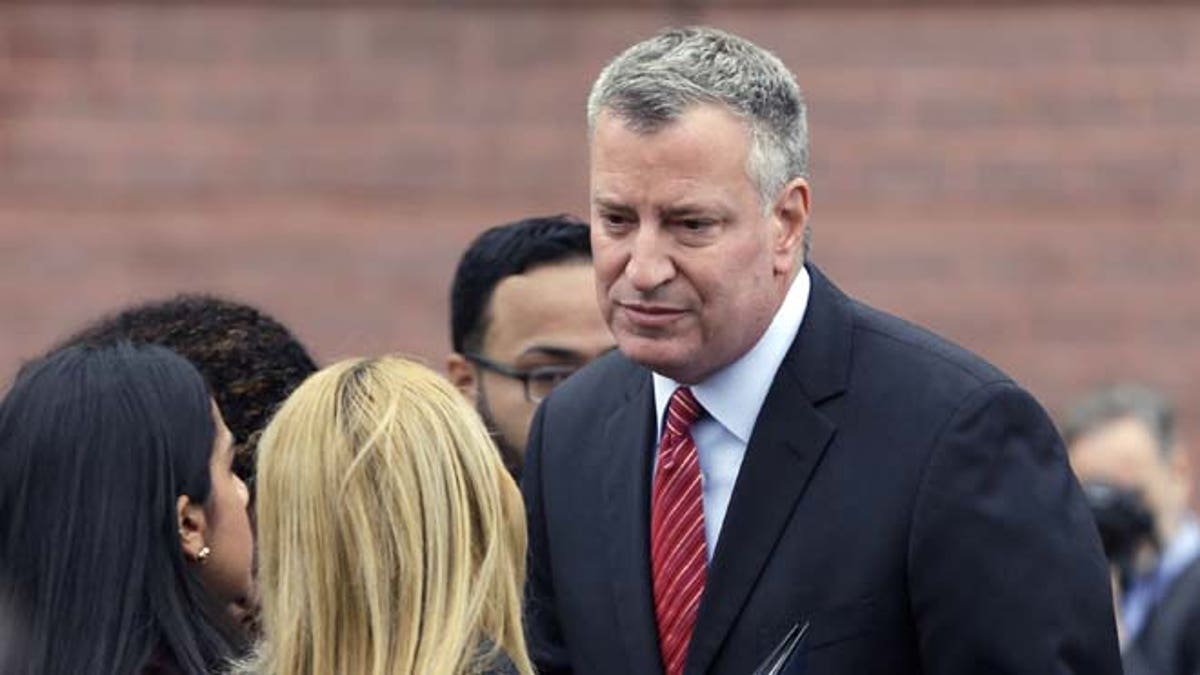
In this Wednesday, Nov. 12, 2014 photo New York City Mayor Bill de Blasio greets family members at the Flight 587 Memorial in the Rockaways section in New York. (AP)
New York City’s new Democratic mayor is planning to unravel the country’s largest local “workfare” program – which ties work requirements to welfare benefits – and revert to what critics are calling an old-fashioned “entitlement” system.
Supporters of the move say the overhaul will end a “punitive” program that forces participants to work in low-end jobs with little more than a welfare check to show for it.
But others say Mayor Bill de Blasio is taking a step backwards and returning to a welfare “status quo” that has been proven not to work. The push by de Blasio heads in the opposite direction from other local governments, even in the Northeast. In Maine, GOP Gov. Paul LePage has tightened restrictions on welfare and Massachusetts’ incoming Republican governor is looking to go a similar route.
Yet in the Big Apple, de Blasio is looking to overhaul the city’s longstanding “workfare” program.
“Workfare” has been around since the late 1960’s, but was popularized in 1995 when former New York City Mayor Rudy Giuliani enacted the nation’s largest workfare system. The Work Experience Program requires welfare recipients to take on “non-employee” jobs across the city like answering phones or providing janitorial services.
Within five years, under Giuliani’s administration, more than 36,000 people had been assigned to the program or were already working under it. The program’s perceived success lent credence to the Personal Responsibility and Work Opportunity Reconciliation Act (PRWOA) of 1996 – also known as welfare reform -- which essentially created a nationwide workfare-lite, among other changes.
Now, roughly 56,000 people are enrolled in the New York program. But under de Blasio’s proposed agenda, Giuliani’s Work Experience Program will be phased out within the next two years and replaced with internship and community service options, as well as more flexible options for education and training.
According to David Neustadt, deputy commissioner of the Human Resources Administration in New York, the 35-hour minimum workweek requirement won’t change for most recipients. But programs will be put in place to “emphasize job training, internships and work experience tied to industries that are growing and creating jobs,” in an attempt to personalize job placement.
Opponents of workfare programs have likened the approach to “modern-day slavery,” saying participants work just like regular employees but are not considered full employees, and consequently do not receive paychecks or benefits. Supporters, however, argue the program limits welfare dependency and demands accountability from its recipients, encouraging everyone in the community to pull their own weight.
Robert Rector of the Heritage Foundation, a major player in the penning of national welfare reform, calls the dismantling of the WEP “wrong” and says it all boils down to whether federal taxpayers should be expected to pay for this “nonsense.”
“This is just a reversion to the pre-welfare-reform status quo, which has been proven to fail,” he said. “Once you set aside Medicaid … about 90 percent of welfare comes from federal money. De Blasio’s very happy to waste federal money, but not ready to waste New York state money.”
Jason Turner, former commissioner of the Human Resources Administration under Giuliani, had a similar take and has called de Blasio’s plan “misguided” and a return to “welfare entitlement.”
“The Work Experience Program has two objectives… the first relates to civic engagement so that people who are receiving benefits from taxpayers have an opportunity to contribute back to the city in the form of temporary or part-time jobs,” he said. The second, he said, is that it acts as a learning tool for those who have been out of the workforce by helping them to relearn personal accountability, attendance and the importance of following directions.
Arnold Cohen, president and CEO of Partnership of the Homeless, disagrees.
According to Cohen, the success of the workfare program cannot be measured simply by how many people were dumped off the welfare rolls, but instead needs to account for the number of people who actually have found permanent or long-term employment — only about 5 percent, by some estimates — and the high level of homelessness in the city.
“Folks have not lifted themselves out of poverty, and have in many ways become more deeply entrenched in poverty,” Cohen told FoxNews.com. “There really is a need for a paradigm shift around work, but it hasn’t been successful in the workfare. …We’ve used [workfare], in a sense, as a punitive measure.”
Still, whether directly attributable to workfare or not, New York did see a significant decrease in welfare recipients under Giuliani’s program. During his tenure as mayor, the number of people receiving welfare benefits dropped from 1.1 million people to 462,000 — a 58.5 percent drop — and crime rates fell similarly during this time. However, both of these slopes reflect national trends that began before he took office.
Meanwhile, in Massachusetts, Republican governor-elect Charlie Baker says he hopes to “foster economic independence” through a plan that would require anyone over 18 seeking benefits to participate in job training or another workfare-style program called “Pathways to Self-Sufficiency” -- and “search for employment” before they can receive cash benefits.
In Maine, LePage also wants to reduce what he describes as “bloated” government assistance by cutting back on “big expensive welfare programs riddled with fraud and abuse.”
The two-term governor and former Waterville mayor also has implemented a five-year limit on welfare benefits and approved drug testing for welfare recipients who have been convicted of narcotics-related crimes.
According to the Census Bureau, an estimated 110 million Americans currently receive some sort of government assistance.




